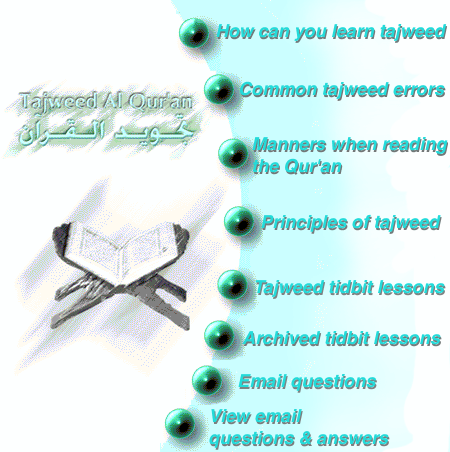Question
May Allah reward you for
your informative answers. In the aayah 15 from surat Yunus
 the
word:
the
word:
 appears, how would we start
on this word were we to start on it? Although it would definitely not be
a good start because of the meaning, so the question is really only
to understand how one would start on such a word were one to occur where a
good start was possible. Jazakumu Allahu khairan.
appears, how would we start
on this word were we to start on it? Although it would definitely not be
a good start because of the meaning, so the question is really only
to understand how one would start on such a word were one to occur where a
good start was possible. Jazakumu Allahu khairan.
Answer
Masha' Allah, that is a
very good question, that requires a bit of explanation.
The word
 is the command form of a
verb. In verbs that start with a
hamzah wasl, we look at the vowel on the third letter of the verb, if it is a
kasrah or a fat-h, we start the hamzah wasl with a kasrah. This is
only applied when starting the verb, if we are continuing in reading, which as
stated in the question, will be the normal state, we will ignore the hamzah
wasl. Also as stated in the
question, this is a hypothetical question, since we should completely avoid
starting on this word in this aayah. There
are other places in the Qur’an where this word or a derivative of this word
appear and it is allowed to start on it, so we using this example for teaching
purposes only. The third
letter in this verb has a kasrah on it, so we would start the hamzah wasl with
a kasrah. The hamzah wasl when
employed, which is only when starting a word with it, is pronounced as a
hamzah. If we look at the second
letter in this word, it is a regular hamzah with a sukoon.
If we were to start this word then, we would have two hamzahs next to
each other, the first with a kasrah (as we now determined the hamzah wasl
would acquire), the second with a sukoon.
There is an rule that when there are two hamzahs, the first with a
vowel, the second with a sukoon, the second hamzah is changed for a medd
letter, which would be the medd letter that corresponds to the vowel on the
first hamzah. We know now that
the first hamzah, when starting this verb, will have a kasrah, so this rule
now in affect means we change the second hamzah to a ya’, since that is the
medd letter that the kasrah comes from. This
word then would be read as:
is the command form of a
verb. In verbs that start with a
hamzah wasl, we look at the vowel on the third letter of the verb, if it is a
kasrah or a fat-h, we start the hamzah wasl with a kasrah. This is
only applied when starting the verb, if we are continuing in reading, which as
stated in the question, will be the normal state, we will ignore the hamzah
wasl. Also as stated in the
question, this is a hypothetical question, since we should completely avoid
starting on this word in this aayah. There
are other places in the Qur’an where this word or a derivative of this word
appear and it is allowed to start on it, so we using this example for teaching
purposes only. The third
letter in this verb has a kasrah on it, so we would start the hamzah wasl with
a kasrah. The hamzah wasl when
employed, which is only when starting a word with it, is pronounced as a
hamzah. If we look at the second
letter in this word, it is a regular hamzah with a sukoon.
If we were to start this word then, we would have two hamzahs next to
each other, the first with a kasrah (as we now determined the hamzah wasl
would acquire), the second with a sukoon.
There is an rule that when there are two hamzahs, the first with a
vowel, the second with a sukoon, the second hamzah is changed for a medd
letter, which would be the medd letter that corresponds to the vowel on the
first hamzah. We know now that
the first hamzah, when starting this verb, will have a kasrah, so this rule
now in affect means we change the second hamzah to a ya’, since that is the
medd letter that the kasrah comes from. This
word then would be read as:
 , with a two vowel count
lengthening, but the writing of the word stays the same:
, with a two vowel count
lengthening, but the writing of the word stays the same:
 .
The rule is the medd bedl
.
The rule is the medd bedl
(
 ) rule.
) rule.
Just to be very clear,
when reading this word in continuum with the word before it, we do not use the
hamzah wasl, and go directly to the hamzah saakinah, then to the
 with
the kasrah. There would be no changing of the second hamzah in this case,
it only occurs when we start the word with the hamzah wasl, which gets a
kasrah. Again, the reason for the
second hamzah becoming a lengthened
with
the kasrah. There would be no changing of the second hamzah in this case,
it only occurs when we start the word with the hamzah wasl, which gets a
kasrah. Again, the reason for the
second hamzah becoming a lengthened
 is
because of the two hamzahs next to each other, both being utilized, the first
voweled, the second saakinah.
is
because of the two hamzahs next to each other, both being utilized, the first
voweled, the second saakinah.
And may Allah reward you
and all Muslims with goodness.
